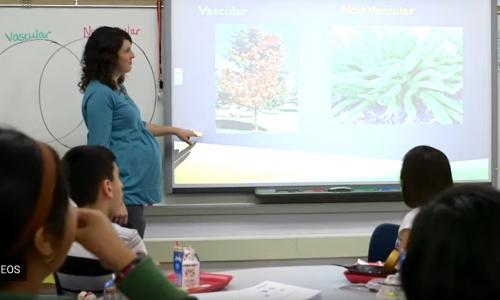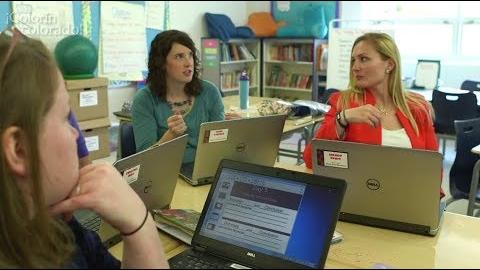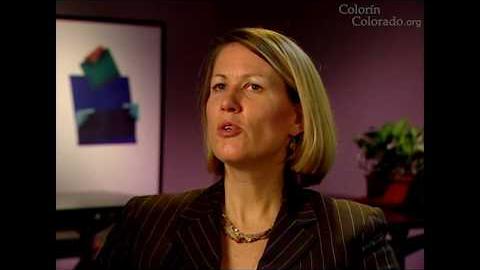Pre-teaching Content and Vocabulary

Pre-teaching content and vocabulary can help prepare students for content-area instruction by giving them a chance to get familiar with the material prior to the lesson. This strategy is part of Colorin Colorado's ELL Strategy Library and can be used to support academic language development for all students.
Strategy Overview
How This Strategy Supports Language Development
Pre-teaching gives students an entry point when learning new content or new vocabulary words. Rather than "starting from scratch" during a new lesson, they will already have some familiarity with the target information and language — a foundation on which to build. This can also improve their engagement and confidence when participating in class discussions.
Pre-teaching can be embedded in the beginning of the lesson. It can also be introduced during small group work, in collaboration with another teacher or specialist, as part of an intervention, or during another part of the day.
For example, ESOL specialist Katy Padilla created a "Super Secret Science Club" at lunch and used the time to preview the science lessons that the students would be seeing in the afternoon with images on slides and videos. She has found success with pre-teaching, which she says makes kids "experts" in the new content before they see it in the larger classroom setting.
Step-by-Step Instructions
Before the lesson
- Identify some key vocabulary words and/or concepts that you wish to highlight, with a special focus on the main objectives of the lesson or what the students may not be familiar with. (If another teacher will be teaching the lesson, get their input on key objectives and vocabulary for the lesson and then be sure to share what you have previewed with students.)
- Look for different ways to present the new content and vocabulary, such as the use of images, videos, student glossaries, realia, and short text summaries.
- Give students lots of chances to practice hearing, reading, speaking, and saying new words, as well as discussing new content, so that they feel comfortable with what they are learning. If possible, preview some examples of what students might see in the lesson.
During the lesson
- If you are teaching or co-teaching the lesson, get students to "show what they know" during the class period through their participation, discussion, and classwork. Pay close attention to how comfortable students feel with the content and their new vocabulary words.
- If you aren't in the room during the lesson, ask the teacher who is delivering the lesson to pay attention to how students are engaging with the content and share their observations with you.
After the lesson
- Make note of how much students participated, whether they used their new target words, and what impact the pre-teaching had on their engagement.
- Reflect on what worked or what didn't work so that you can continue to make the most of your pre-teaching time.
Differentiation
- Use scaffolds such as visuals, video/audio transcripts, graphic organizers, resources in students' home languages, and realia.
- Give students an opportunity to discuss content with partners before sharing with the whole group, including with peers who speak the same home language.
Lessons Learned
- Select 3-5 essential concepts and terms for pre-teaching. Give students confidence with a few items rather than overwhelming them with pre-teaching the entire lesson.
- Always teach the new vocabulary words in connection with the content students will be learning, rather than as a list of words. Use the visuals, videos, experiments, etc. to connect the words to the content.
- Explicitly connect the new content and concepts with the students' existing background knowledge. Build on what they already know.
- As you figure out how to make the most of your pre-teaching time, shared your lessons learned with colleagues so that they can try this strategy too.
Co-Teaching Considerations
Content or Grade-Level Teacher
- Identify key concepts and vocabulary words for your lesson.
- Look for resources that present and highlight this content that can be used for teaching and previewing.
English Language Development Teacher
- If needed, collaborate with your co-teacher to select vocabulary and main ideas that will support understanding of the lesson.
- Identify some different ways to introduce the new content and words to students, as well as to practice using the new language.
Example
| Science (Gr. 3-5) | Why Daylight Changes in the Seasons |
|---|---|
Overview
| Lesson Plan: Changing Daylight in Summer and Winter is an upper elementary science lesson from PBS Learning Media. Here are some different ways you could pre-teach this content before the lesson. |
| Activate prior knowledge | Look for ways to make connections to students' prior experience and background knowledge. See the lesson plan's Teaching Tips for prompts. |
| Video | Sunny Summer Nights (Molly of Denali) This short video from the PBS Kids series Molly of Denali features two Iñupiaq young people in Utqiagvik, Alaska, a town above the Arctic Circle. The young people describe the phenomenon of the sun never setting in the summer and never rising in the winter. The clip also includes some words in Iñupiaq (available in the captions). |
| Vocabulary + images | Show students "Illuminating Earth in June and December," an image included in the lesson plan materials. Use the image to teach students the following vocabulary words, providing student-friendly definitions:
Then ask students to describe the image with a partner using their new vocabulary words. How does the image relate to the video of the young people in Utqiagvik? |
| Home language support | This lesson plan is available in Spanish. For Spanish-speaking students who need additional scaffolding, you may wish to have them look at the materials or view the videos in Spanish first. Students can also discuss the content in their home language and then report what they learned in English. |
| Lesson plan materials | The lesson plan includes a number of materials that you can use before viewing the videos, including:
|
| Teaching the lesson |
|
Videos: Pre-teaching Content and Vocabulary
This video showcases a 5th-grade team planning a science lesson about the difference between vascular and non-vascular plants. ESOL specialist Katy Padilla plays a key role in advocating for ELLs throughout the lesson planning process and sharing her strategies for engaging and supporting students. In the bonus interview clips, she also talks about her "Super Secret Science Club," an informal lunch activity for 5th-grade ELLs where they see a preview of the afternoon's lesson. In the video below, ELL expert Susan Lafond offers some ideas for pre-teaching concepts before a lesson.




